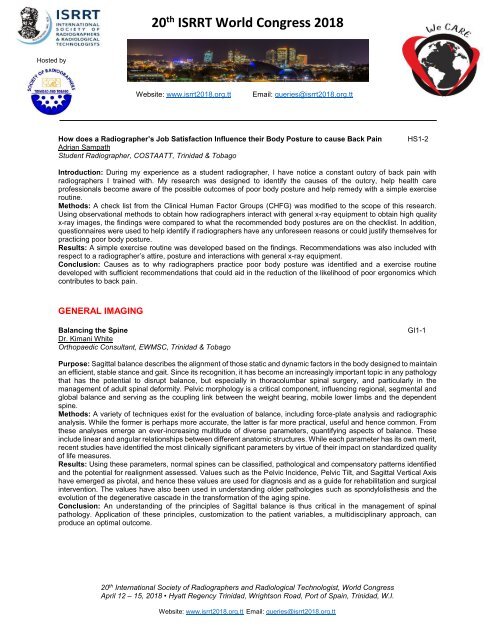Trinidad-and-Tabago-Congerss-Abstract-Book
You also want an ePaper? Increase the reach of your titles
YUMPU automatically turns print PDFs into web optimized ePapers that Google loves.
20 th ISRRT World Congress 2018<br />
Hosted by<br />
Website: www.isrrt2018.org.tt<br />
Email: queries@isrrt2018.org.tt<br />
How does a Radiographer’s Job Satisfaction Influence their Body Posture to cause Back Pain<br />
Adrian Sampath<br />
Student Radiographer, COSTAATT, <strong>Trinidad</strong> & Tobago<br />
HS1-2<br />
Introduction: During my experience as a student radiographer, I have notice a constant outcry of back pain with<br />
radiographers I trained with. My research was designed to identify the causes of the outcry, help health care<br />
professionals become aware of the possible outcomes of poor body posture <strong>and</strong> help remedy with a simple exercise<br />
routine.<br />
Methods: A check list from the Clinical Human Factor Groups (CHFG) was modified to the scope of this research.<br />
Using observational methods to obtain how radiographers interact with general x-ray equipment to obtain high quality<br />
x-ray images, the findings were compared to what the recommended body postures are on the checklist. In addition,<br />
questionnaires were used to help identify if radiographers have any unforeseen reasons or could justify themselves for<br />
practicing poor body posture.<br />
Results: A simple exercise routine was developed based on the findings. Recommendations was also included with<br />
respect to a radiographer’s attire, posture <strong>and</strong> interactions with general x-ray equipment.<br />
Conclusion: Causes as to why radiographers practice poor body posture was identified <strong>and</strong> a exercise routine<br />
developed with sufficient recommendations that could aid in the reduction of the likelihood of poor ergonomics which<br />
contributes to back pain.<br />
GENERAL IMAGING<br />
Balancing the Spine<br />
Dr. Kimani White<br />
Orthopaedic Consultant, EWMSC, <strong>Trinidad</strong> & Tobago<br />
GI1-1<br />
Purpose: Sagittal balance describes the alignment of those static <strong>and</strong> dynamic factors in the body designed to maintain<br />
an efficient, stable stance <strong>and</strong> gait. Since its recognition, it has become an increasingly important topic in any pathology<br />
that has the potential to disrupt balance, but especially in thoracolumbar spinal surgery, <strong>and</strong> particularly in the<br />
management of adult spinal deformity. Pelvic morphology is a critical component, influencing regional, segmental <strong>and</strong><br />
global balance <strong>and</strong> serving as the coupling link between the weight bearing, mobile lower limbs <strong>and</strong> the dependent<br />
spine.<br />
Methods: A variety of techniques exist for the evaluation of balance, including force-plate analysis <strong>and</strong> radiographic<br />
analysis. While the former is perhaps more accurate, the latter is far more practical, useful <strong>and</strong> hence common. From<br />
these analyses emerge an ever-increasing multitude of diverse parameters, quantifying aspects of balance. These<br />
include linear <strong>and</strong> angular relationships between different anatomic structures. While each parameter has its own merit,<br />
recent studies have identified the most clinically significant parameters by virtue of their impact on st<strong>and</strong>ardized quality<br />
of life measures.<br />
Results: Using these parameters, normal spines can be classified, pathological <strong>and</strong> compensatory patterns identified<br />
<strong>and</strong> the potential for realignment assessed. Values such as the Pelvic Incidence, Pelvic Tilt, <strong>and</strong> Sagittal Vertical Axis<br />
have emerged as pivotal, <strong>and</strong> hence these values are used for diagnosis <strong>and</strong> as a guide for rehabilitation <strong>and</strong> surgical<br />
intervention. The values have also been used in underst<strong>and</strong>ing older pathologies such as spondylolisthesis <strong>and</strong> the<br />
evolution of the degenerative cascade in the transformation of the aging spine.<br />
Conclusion: An underst<strong>and</strong>ing of the principles of Sagittal balance is thus critical in the management of spinal<br />
pathology. Application of these principles, customization to the patient variables, a multidisciplinary approach, can<br />
produce an optimal outcome.<br />
20 th International Society of Radiographers <strong>and</strong> Radiological Technologist, World Congress<br />
April 12 – 15, 2018 • Hyatt Regency <strong>Trinidad</strong>, Wrightson Road, Port of Spain, <strong>Trinidad</strong>, W.I.<br />
Website: www.isrrt2018.org.tt Email: queries@isrrt2018.org.tt


















